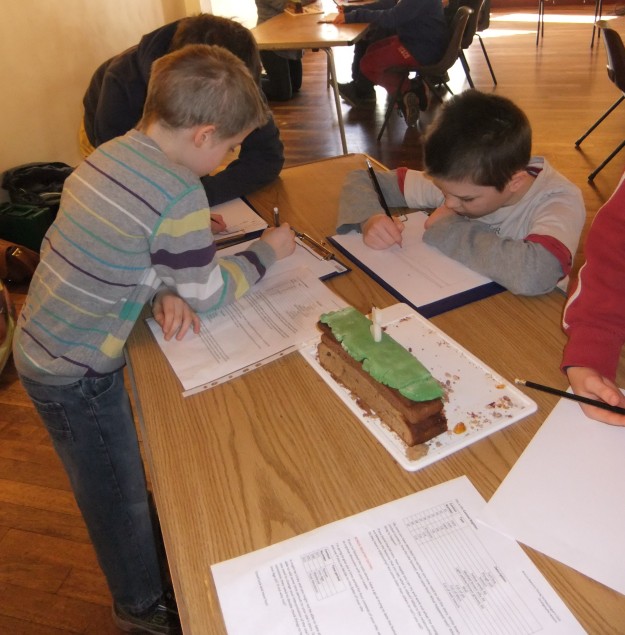In our April session we learned all about stratigraphy – that’s all the different layers in the soil that helps us to understand how archaeological sites developed, the age of different layers and helps us to tell the story of what happened.
We started off learning all about stratigraphy and how it can help us to date what we find – generally the lower down the older it is, each layer taking us further back in time. How each layer or deposit, and also each action or cut down into it, is given a unique number, called a Context Number, to help us to unpick and accurately record the site. We learned that for contexts that are layers or deposits the number is put in round brackets like this (100) and contexts that are cuts are put in square brackets, like this [102].
We then had a go at building our own archaeological sites, our own stratigraphy, using cakes. We used different coloured cakes for the different layers of soil and green icing as the grass. We cut little ditches and pits into our layers of cake, filling them with different fills – crushed biscuits, rice crispies etc., and we cut foundation trenches and built walls out of pink wafer biscuits, everything held together by generous amounts of apricot jam! We worked in groups, using a section drawing as a guide, so we knew where and how to build our features. Here are all our different elements that we used to build our site stratigraphy – they are all labelled with their context numbers.
Here are all our different elements that we used to build our site stratigraphy – they are all labelled with their context numbers.
 Here is a group having fun and building their stratigraphy, and you can see the section drawing they are working from.
Here is a group having fun and building their stratigraphy, and you can see the section drawing they are working from.
 Here is one of our finished stratigraphy cakes – pink wafer wall, with a crushed biscuit filled pit and and a rice crispy filled pit.
Here is one of our finished stratigraphy cakes – pink wafer wall, with a crushed biscuit filled pit and and a rice crispy filled pit.
After a quick refreshments break, we swapped sites with another group, and set about working out the story of the site that the stratigraphy was telling us, recording the layers and features in a section drawing, carefully labelling each context, remembering to use our (round brackets) and [square brackets] for for deposits and cuts, produced a Context Register describing all our contexts – texture, colour, and tried to work out some relative dating of our features. Carefully recoding our sections.
Carefully recoding our sections.
We ended the session with some well deserved slices of cakes – but thankfully not the ones we made, which at this point were far from edible!

